
As this is a legacy project we will continue to steward this watershed. Please check back for project updates.
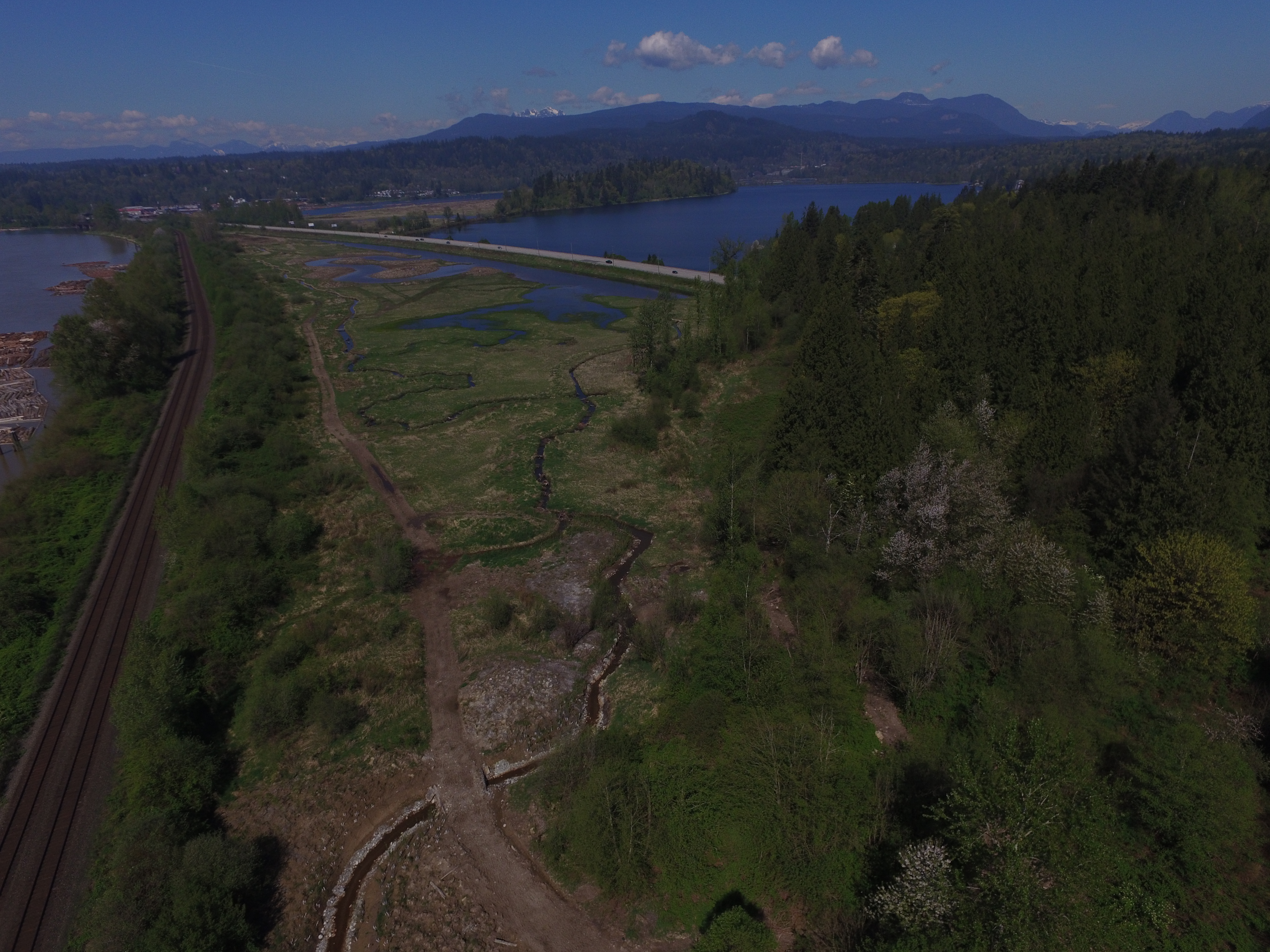
Photo: Aerial view of Stave Site #3 located south of Silvermere Lake and Highway #7 and an east bank off-channel of the Stave River. Site #3 was built on Ducks Unlimited Property (acquired with funding from Highway #7 widening habitat compensation) and Kwantlen First Nation property.
This on-going project is a collaborative effort to enhance, restore, and promote shared conservation values and improve salmon habitat and overall biodiversity in the Stave River Watershed. Restoration efforts include conserving and maintaining overall spawning habitat and increasing off-channel habitat to support rearing, overwintering, and spawning salmon populations. The goal of this multi-year project is to ensure that long-term resiliency and ecological integrity of the Stave River Watershed is maintained into the future.
Tidally influenced freshwater estuaries and off-channel habitats are critical areas benefiting salmon, waterfowl, mammals, migratory birds, and serving as an important ecosystem for flood protection and human services. Natural off-channel habitats include beaver ponds, wetlands, alcoves, floodplains, side channels and tributaries. The lower Stave River has been regarded as one of the most productive salmon habitats in the province and supports the second largest chum salmon (Oncorhynchus keta) population in the Fraser River watershed. Up to 500,000 chum salmon and hundreds of coho, pink (Oncorhynchus gorbuscha) and chinook (Oncorhynchus tshawytscha) salmon spawn in these graveled channels. The lower Stave River, between the Ruskin Dam and the Fraser River, consists of numerous channels and gravel bars, with predominantly deciduous vegetation growing on the more established bars and riverbanks. Located within the traditional territory of the Kwantlen First Nation, the area contains numerous archaeological sites and artifacts of cultural and historical significance.
The ecology of the lower Stave River has been heavily altered and influenced by human activities since the early 1900’s beginning with lumber and saw milling and continuing to hydroelectrical damming from 1929 to present day. In the 1930’s the Ruskin Dam and Stave Falls Dam were created essentially cutting off the lower Stave River from the upper region except during periodic dam operation. The Ruskin Dam significantly influences the habitat and hydrology of the lower Stave River by limiting the natural deposition of spawning gravel from upstream, altering water and erosion patterns, and by washing spawning gravel further downstream during periodic dam spillway release. The combined influences from operation of the dam and powerhouse restricts the range of habitat salmon can use to the lower 3 km section of the Stave River, reduces the available spawning habitat for salmon from decreased spawning gravel deposition, and threatens the cultural heritage of the area due to increased erosion of important archaeological sites.
Ongoing restoration work in the lower Stave River spans from the Ruskin Dam to the confluence at the Fraser River and aims to:
a) Create and enhance off-channel and mainstem river habitats to support all salmon species.
b) Create and conserve spawning opportunities.
c) Improve floodplain ecology (this includes reducing effects of invasive plants).
d) Address failing infrastructure that could result in barriers to fish passage.
e) Address challenges caused by erosion that negatively impact aquatic fish habitat and result in the loss of cultural artifacts
f) Enhance the river system to provide habitat features for other species at risk including purple martins, western painted turtles, Sandhill cranes, and red-legged frogs; effectively increasing overall biodiversity of the lower Stave River and surrounding areas.
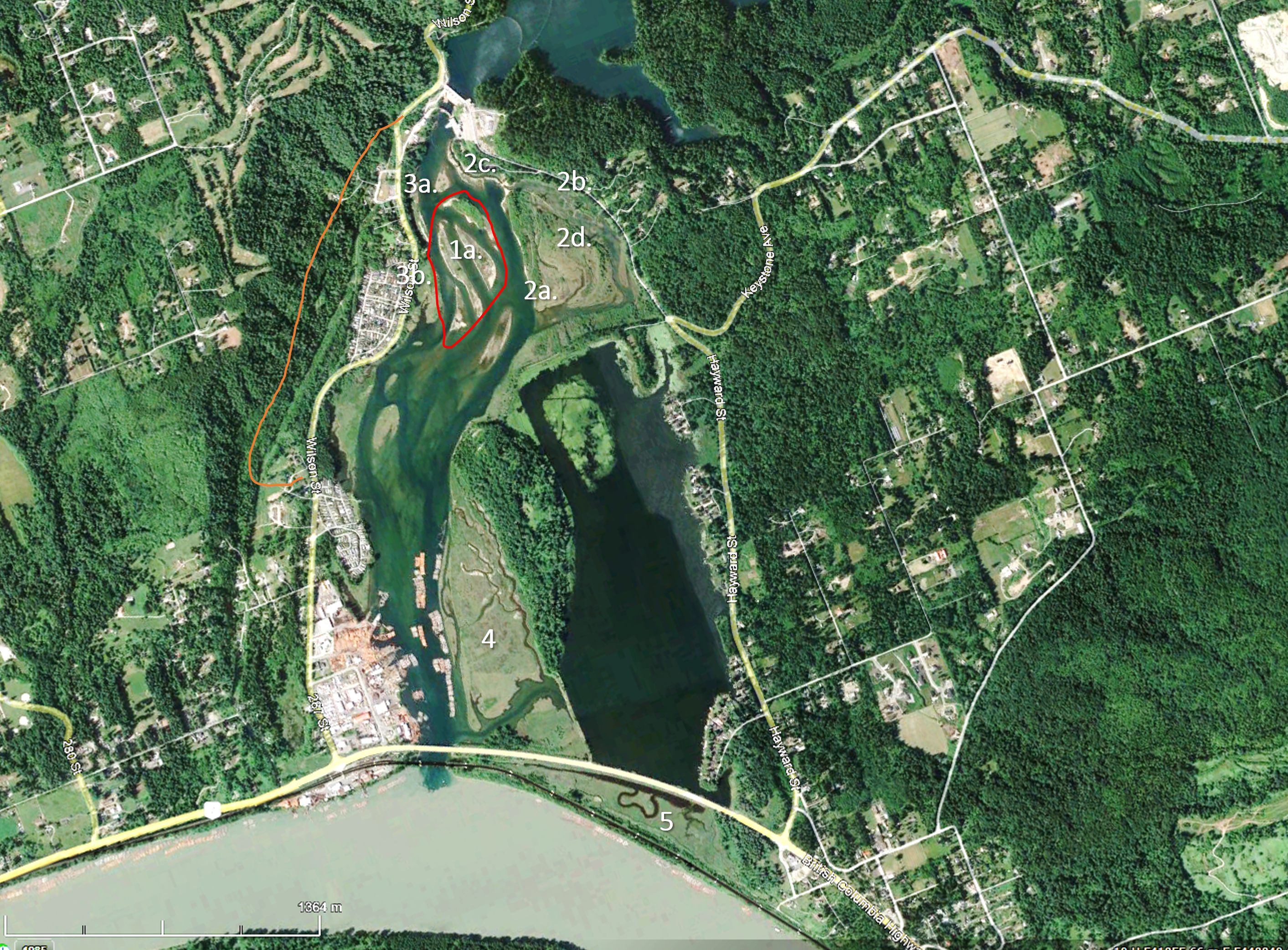
1. Mainstem Channel of the Lower Stave River
1a. Spawning Habitat Restoration
2. Northeast Section of the Lower Stave River
2a. East Bank Stabilization & Conservation of Kwantlen First Nation Archaeological Site
2b. Restoration of East Bank Spillway & Spawning Channel
2c. Ruskin Picnic Site
2d. Ruskin Island (Stave Site #1)
3. West Side of the Lower Stave River
3a. Restoration of West Bank Side Channel
3b. Thompson Creek Restoration & Enhancement (Stave Site #4)
4. Kwantlen First Nation IR#3 (Stave Site #2)
5. Stave Site #3
1. Mainstem Channel of the Lower Stave River
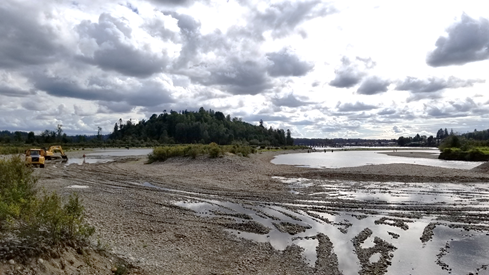
photo: Construction to re-grade and re-contour the mainstem of the Stave River to mitigate the effects of large spillway release from Ruskin Dam and increase spawning habitat for salmon (2018).

photo: Excavator distributing spawning gravel in the mainstem of the Stave River (2018).
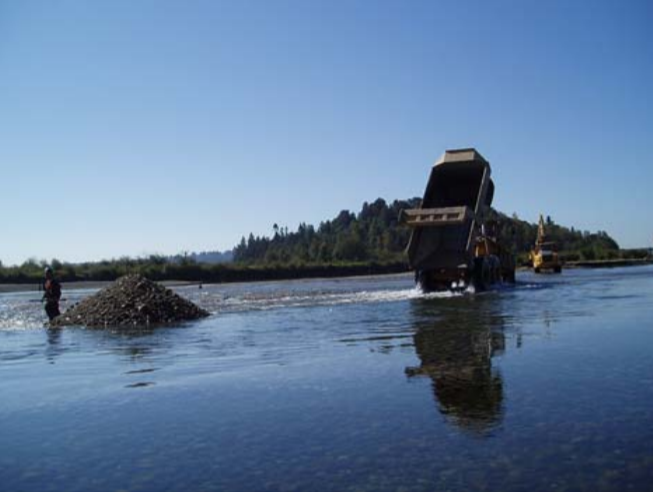
photo: Spawning gravel being added to the mainstem of the Stave River (2008).
Background
The Ruskin Dam and Powerhouse cut off the lower Stave River from natural gravel recruitment and the periodic dam spillway release washes existing gravel further downstream leading to diminished spawning habitat over time. Restoration work needs to be done every 10-20 years to replace spawning gravel in the mainstem of the lower Stave River to conserve these critical spawning grounds for Pacific Salmon. The most recent spawning gravel restoration was completed from 2006-2008 and involved a collaborative effort between the Fraser Valley Watersheds Coalition, Department of Fisheries and Oceans, Fraser Valley Regional District, BC Hydro, and Kwantlen First Nation. Funding for this ongoing project was provided by BC Hydro Bridge Coastal Fish & Wildlife Restoration Program, Department of Fisheries and Oceans, and BC Hydro.
Summary of Activities
1a. Spawning Habitat Restoration (2006-2008)
Created 150 m long spawning gravel bench.
Recontoured spawning gravel to create a 150 m spawning riffle and a 120 m long spawning channel.
Created a series of 3 deep water trenches perpendicular to stream flows to provide resting areas for steelhead and other salmonids during high flows.
2. Northeast Section of the Lower Stave River

photo: Aerial view of Stave Site #1 (Ruskin Island). The upper channel is the east bank spillway/spawning channel constructed around the island and additional channels were constructed running through the island for rearing and overwintering habitat. All channels connect back with the mainstem of the Stave River.
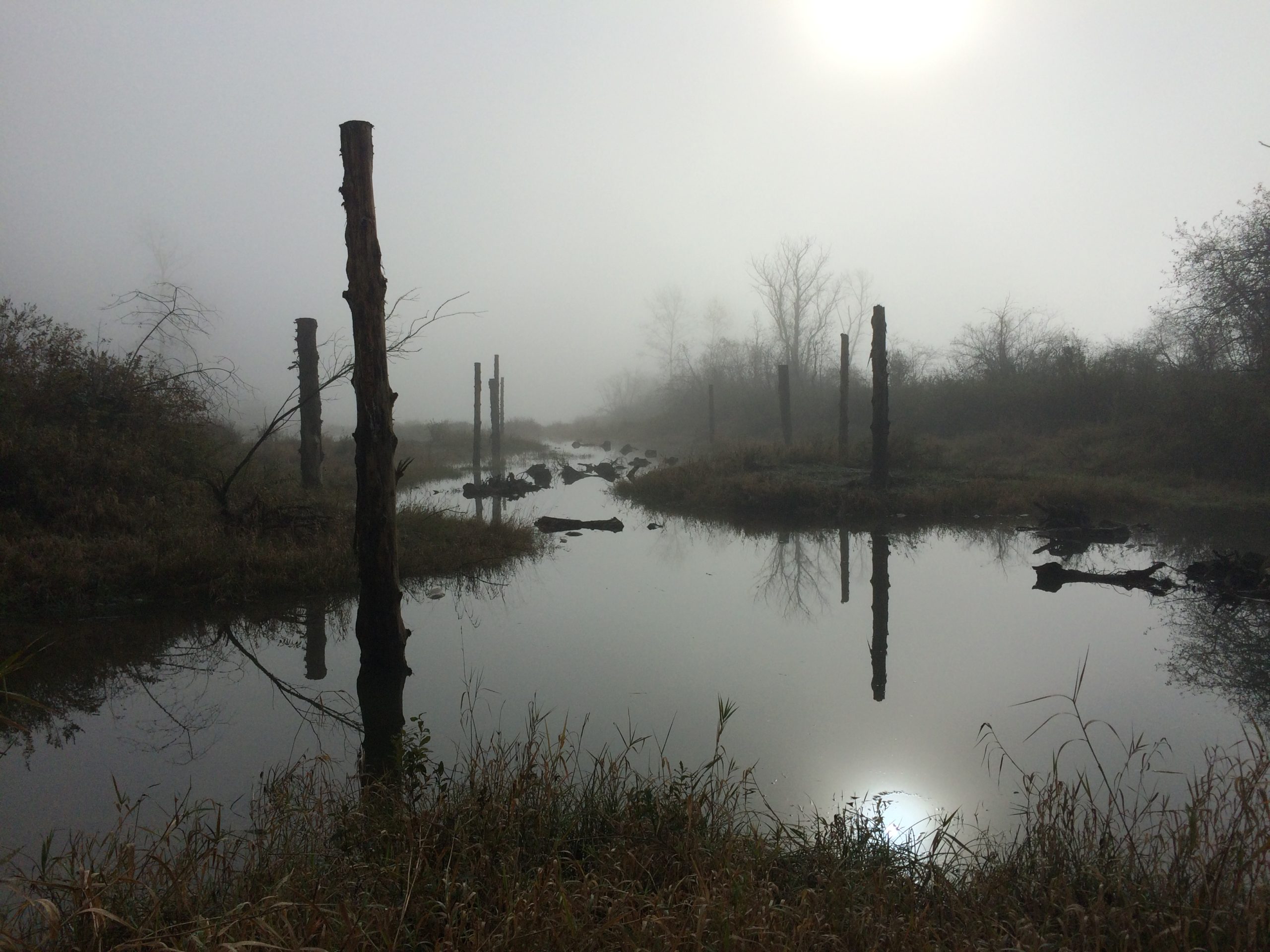
photo: Looking down one of the constructed off-channels through Stave Site #1 (Ruskin Island) on a foggy morning.
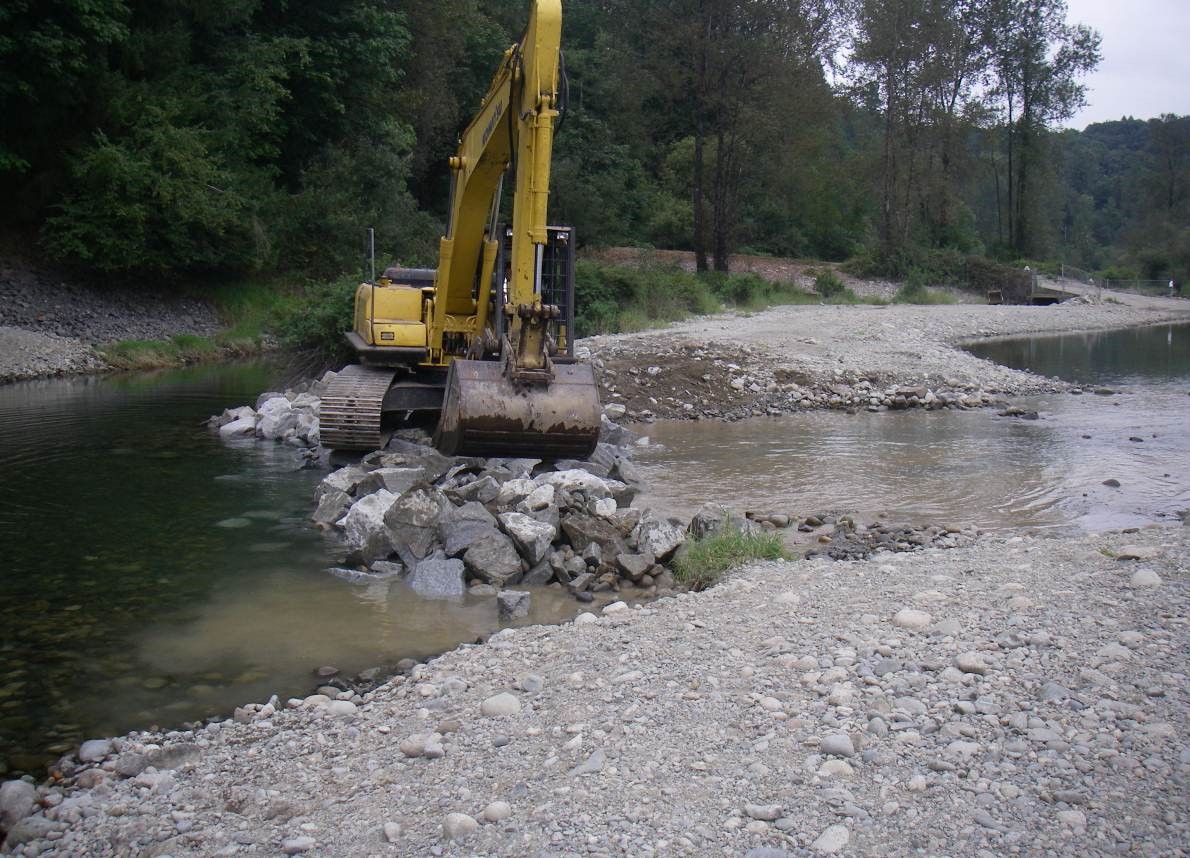
photo: Construction of the Stave Site #1 (Ruskin Island) east bank spillway/spawning channel.

photo: Construction of the new foot bridge at the Ruskin Picnic Site in 2008.
Background
The northeast section of the lower Stave River has had extensive restoration work done between 2008 and 2015. The focus of this section was conserving recreational values, protecting important archaeological sites, and creating and enhancing rearing and spawning habitat for juvenile salmonids. This section was a continuation of funding from BC Hydro Bridge Coastal Fish & Wildlife Restoration Program (now the BC Hydro Fish and Wildlife Compensation Program), Department of Fisheries and Oceans, and BC Hydro.
Summary of Activities
2a. East Bank Stabilization & Protection of Kwantlen First Nation Archaeological Site
Located in the unceded traditional territory of Kwantlen First Nation, the lower Stave River contains numerous archaeological sites and artifacts of cultural significance threatened by the continual erosion of the riverbanks. The Ruskin Dam accelerates the erosion of these important cultural sites due to the periodic large spillway release for Ruskin Dam and Powerhouse operation. The restoration works completed between 2006-2008 also focused on protecting the east bank of the lower Stave River from erosion to protect an important Kwantlen First Nation archaeological site.
Works Completed
175 m of the eastern bank of the lower Stave River was protected using onsite gravel to protect the bank from further erosion resulting in the degradation of spawning beds with fine sediment and risking the destruction of important archaeological sites and artifacts.
2b. Restoration of East Bank Spillway & Spawning Channel
On the east bank of the lower Stave River an off-channel spillway/spawning channel was enhanced and re-watered to create rearing and spawning habitat and to reduce overall erosion and spawning gravel displacement by spreading out the flows in the mainstem Stave River from the Ruskin Dam. The spillway is located adjacent to the Ruskin Picnic Site approximately 200 m downstream of the Ruskin Dam and wraps around the eastern side of Ruskin Island (2d. Stave Site #1). This piece of the project resulted in over 7,000 m2 of redeveloped spawning habitat.
Works Completed
In 2008:
In 2011:
2c. Ruskin Picnic Site
In conjunction with the east bank spillway & spawning channel restoration the adjacent Ruskin Picnic Site was enhanced in 2008 to maintain the recreational value of the site.
Works Completed
2d. Ruskin Island (Stave Site #1)
This portion of the project focused on increasing the quality and quantity of overwintering and rearing habitat for juvenile salmonids including Chum, Coho, Chinook, and cutthroat trout on Ruskin Island adjacent to the east bank spillway and spawning channel of the lower Stave River (referred to as Stave Site #1).
Works Completed
Spring 2013:
Fall 2013:
In 2015:
3. West Side of the Lower Stave River
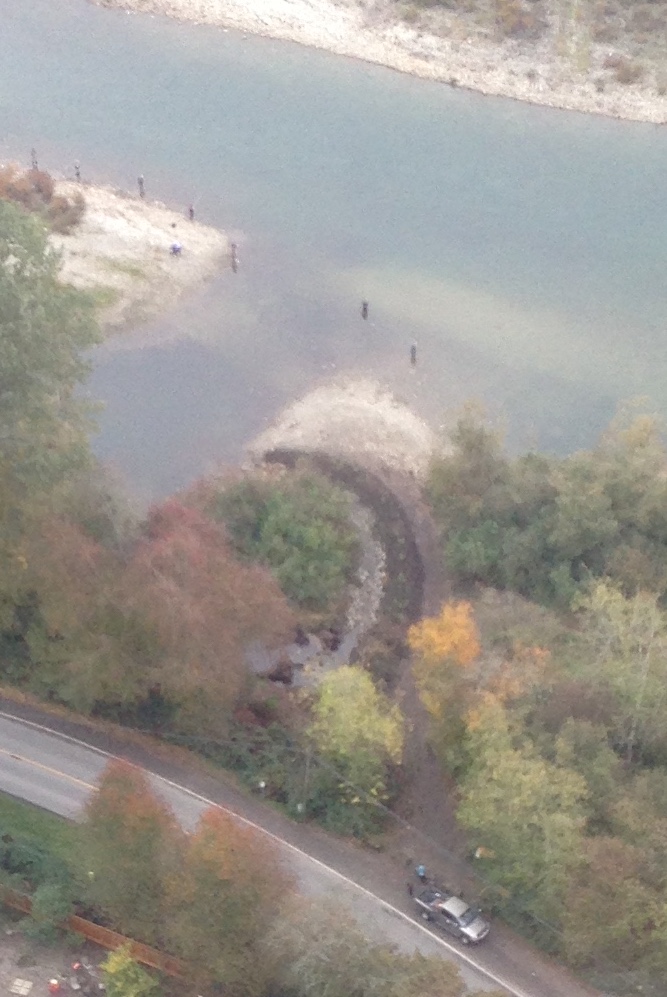
photo: Aerial view of Thompson Creek after construction to re-water the creek and re-align it with the west bank side channel of the Stave River in 2010.
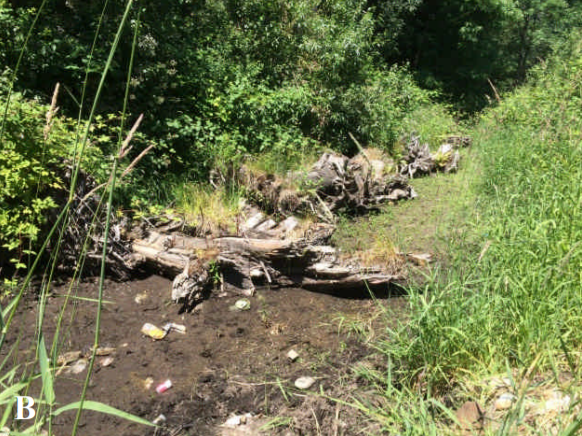
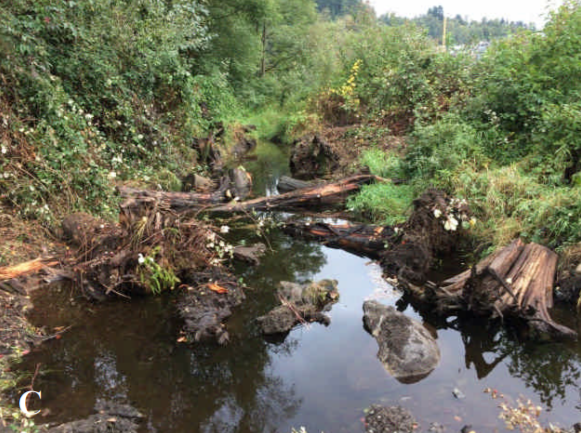
photo: B- photo of the Thompson Creek fishway before restoration in 2015. Note how it is completely de-watered. C-photo of the Thompson Creek fishway after restoration in 2015. The channel is re-watered.
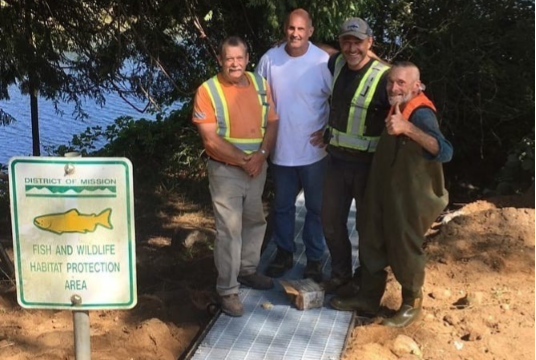
photo: Local resident and DFO pose for a photo on top of the new steel fish ladder at Thompson Creek. The old, failing wooden fish ladder was replaced with a new steel fish ladder in 2019.

photo: FVWC staff put up exclusion fencing to keep fish out of the construction zone while the Thompson Creek fish ladder was being replaced in 2019.
Background
Restoration efforts on the West bank of the lower Stave River focus on restoring and enhancing rearing and spawning habitat. Work focused on the West bank side channel of the Stave River and the tributary Thompson Creek.
Summary of Activities
3a. Restoration of the West Bank Side Channel
The western side channel of the lower Stave River was experiencing low flows due to a failing intake at the northern end just below the Ruskin Dam. The side channel was restored to enhance spawning and rearing habitat for chum and coho salmon.
Works Completed
2010:
3b. Thompson Creek Enhancement (Stave Site #4)
Thompson Creek is a small tributary off of the west bank of the lower Stave River and is important for rearing and spawning salmon. Fish access to Thompson Creek had become significantly reduced due to low water flow from beaver activity and human influence.
Works Completed
2010-2011:
2015:
2019:
4. Kwantlen First Nation IR #3 (Stave Site #2)
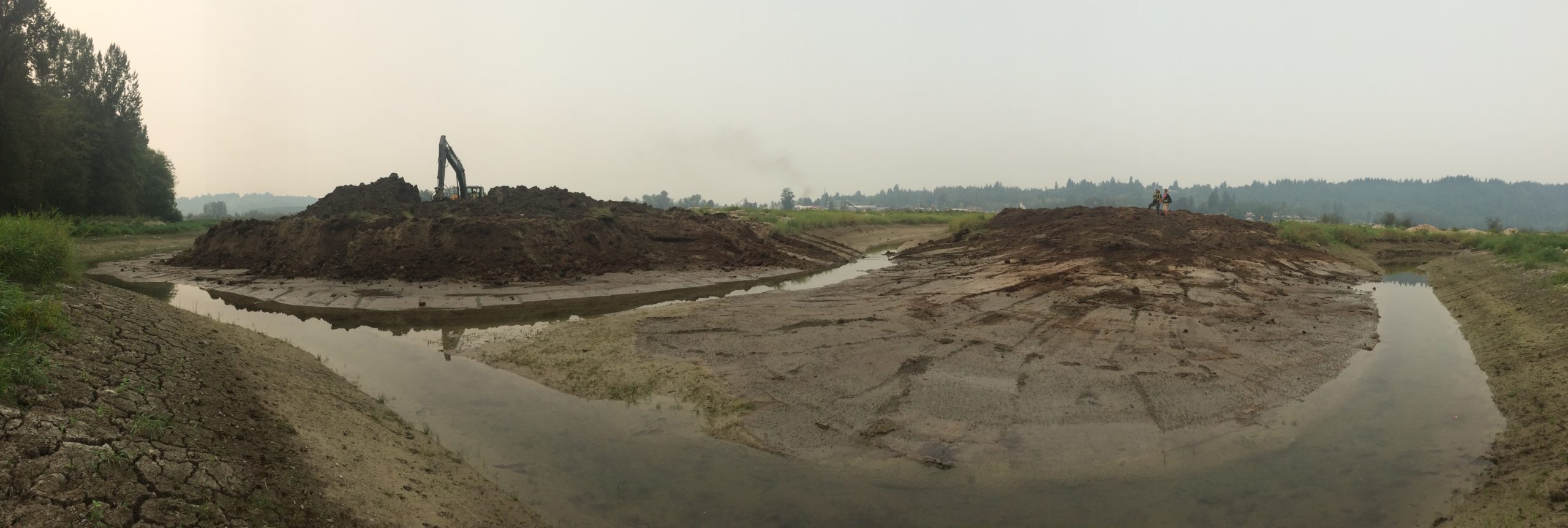
photo: Construction of the Stave Site #2 channels.

photo: Excavator bringing plants in by bucket to re-plant the constructed channels at Stave Site #2.

photo: FVWC team planting aquatic vegetation in the constructed channels at Stave Site #2 (2018).

photo: A group of University of the Fraser Valley (UFV) students planting the banks of the constructed channels at Stave Site #2 with native vegetation (2018).
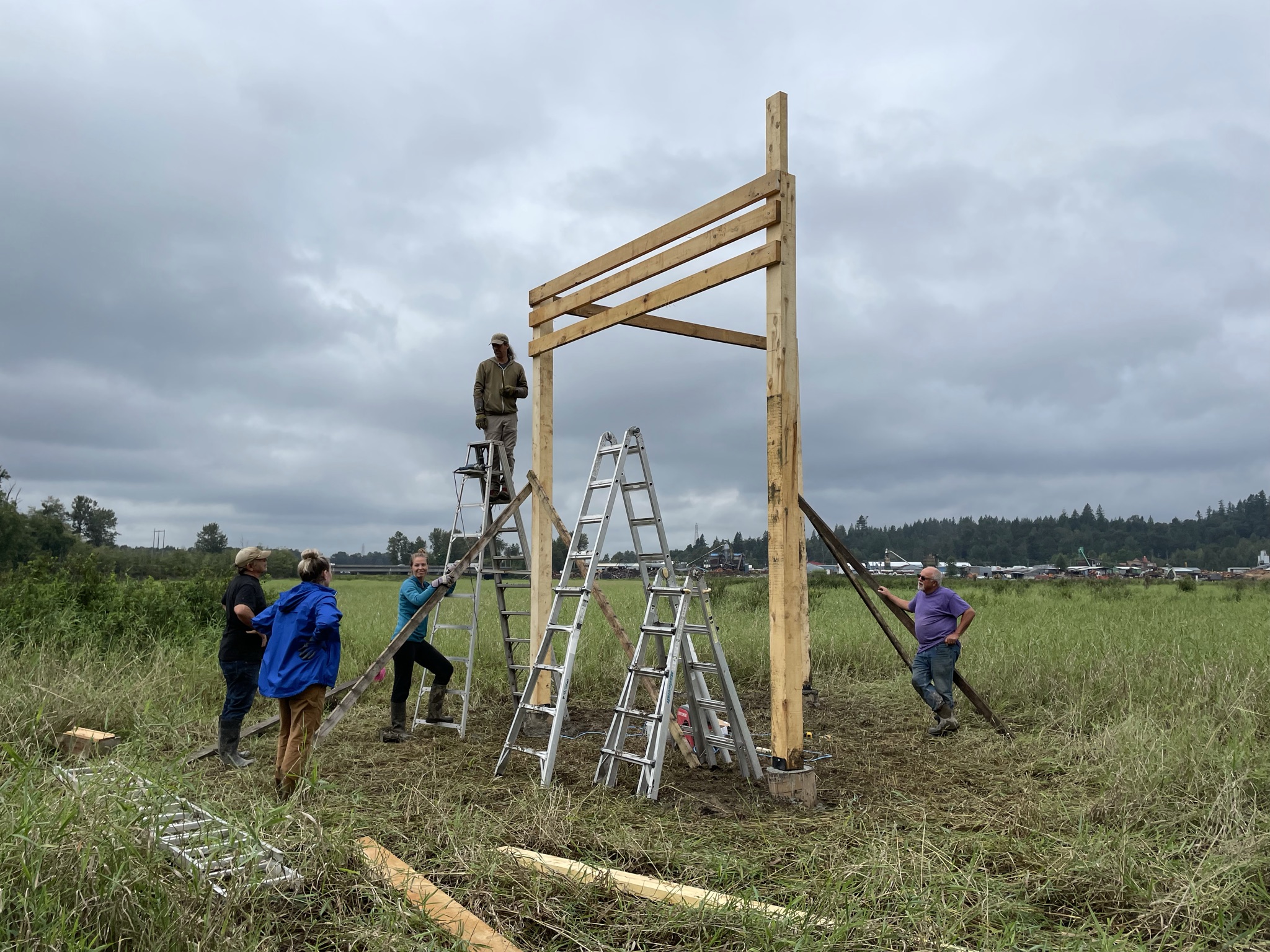
photo: Stave Valley Salmonid Enhancement Society, FVWC, and Kwantlen First Nation construct a Purple Martin nesting box structure at Stave Site #2 in 2021. The structure will house approximately 50 Purple Martin nesting boxes.
Background
Stave Site #2, owned by Kwantlen First Nation, is located in the southeast between the Stave River and Silvermere Lake and is a cultural hotspot for archeological sites and artifacts. Prior to restoration, Stave Site #2 had historical rearing channels that were heavily impacted by invasive reed-canary grass causing low water flow and reduced habitat value for salmonids and other wildlife. These channels are located in a fresh water tidal estuary which are biodiverse habitats important for a range of plant communities, fish, and other wildlife. Restoration efforts focused on creating new and restoring existing off-channels for rearing and overwintering coho salmon, increasing overall habitat value for other species and species-at-risk including great blue heron and Western painted turtle, and conserving the cultural heritage of the site.
Summary of Activities
2015:
2016 - Phase 1:
5. Stave Site #3
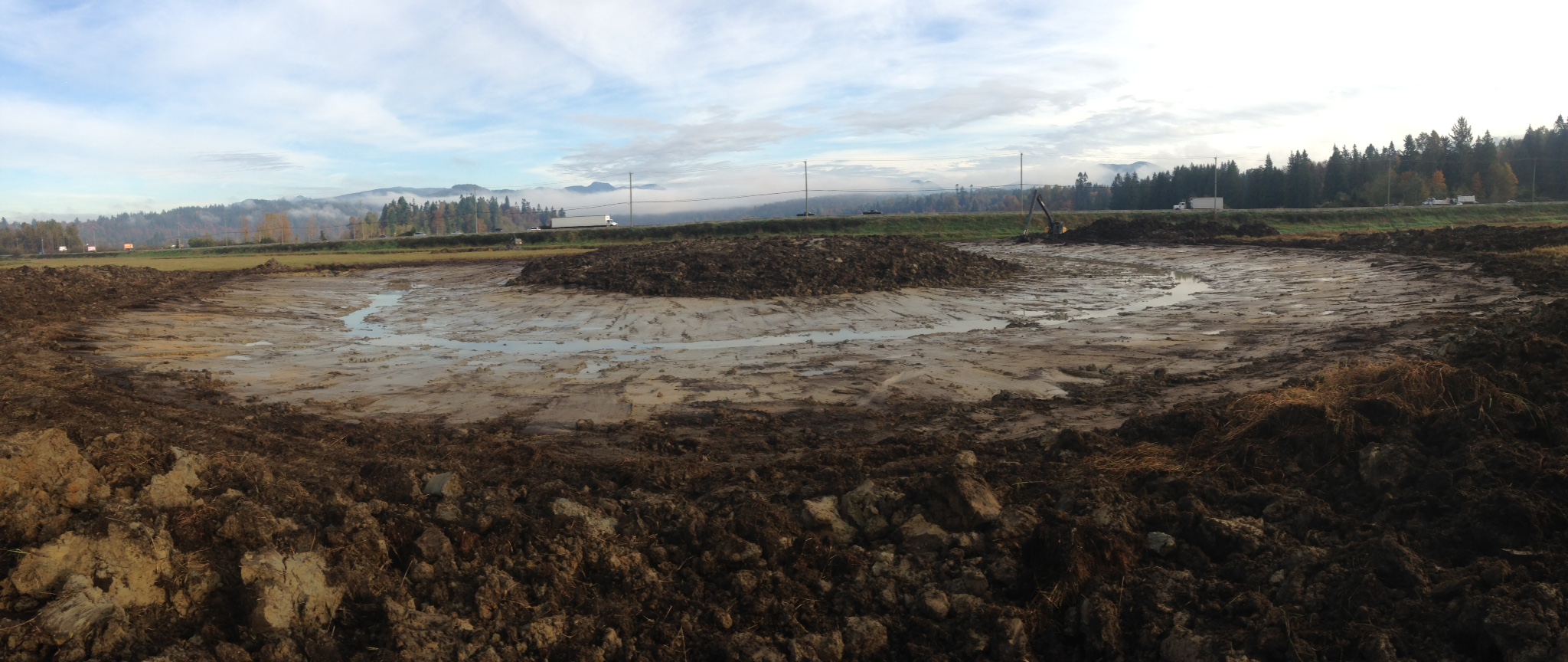
photo: A portion of the constructed channels in Stave Site #3 after restoration (2015).
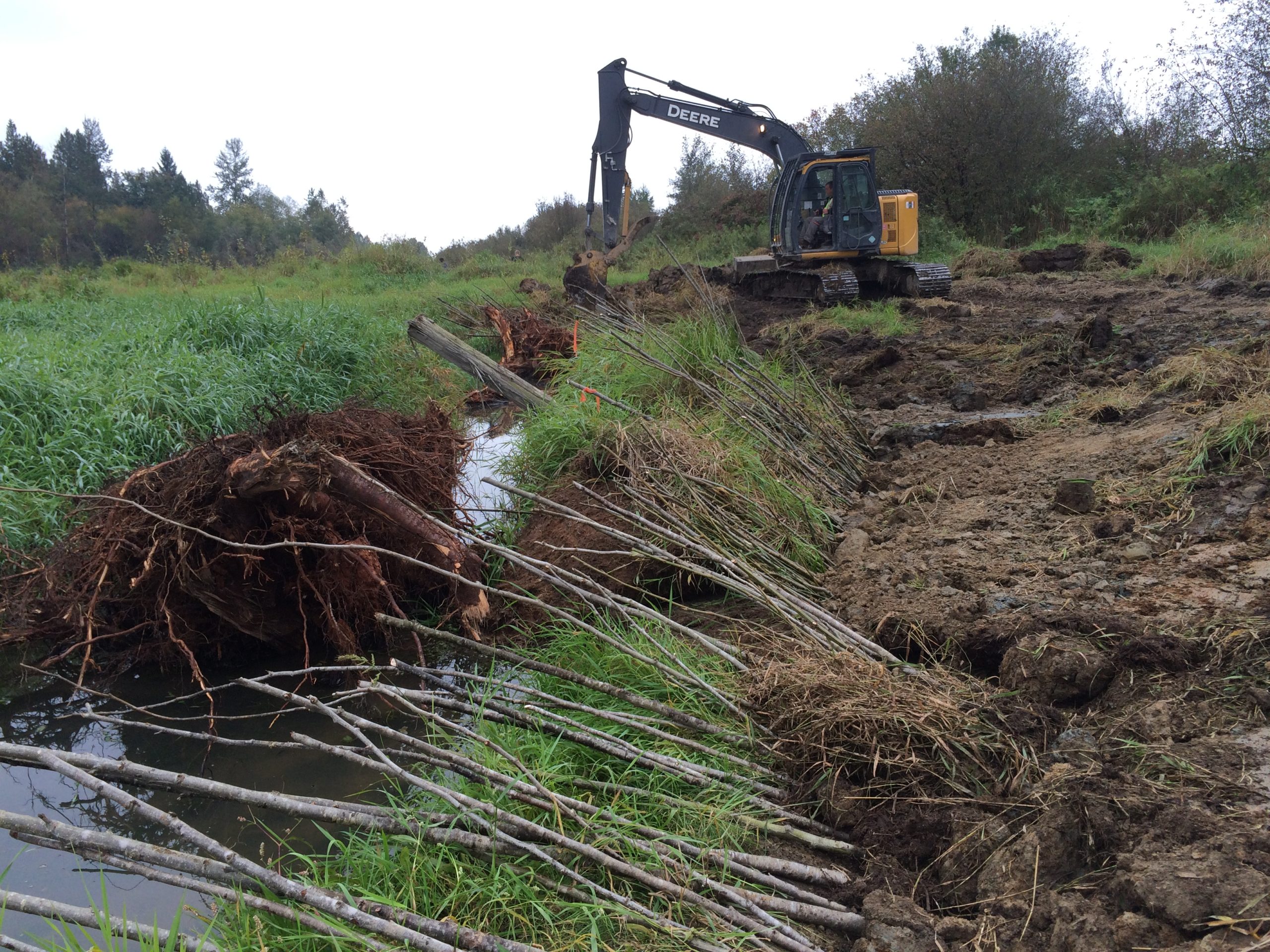
photo: Trench bioengineering at Stave Site #3. The excavator dug a trench which was then planted with large willow stakes and backfilled. The willow will grow to provide riparian vegetation and soil stability.

photo: Aerial view of Stave Site #3 after construction in 2015.
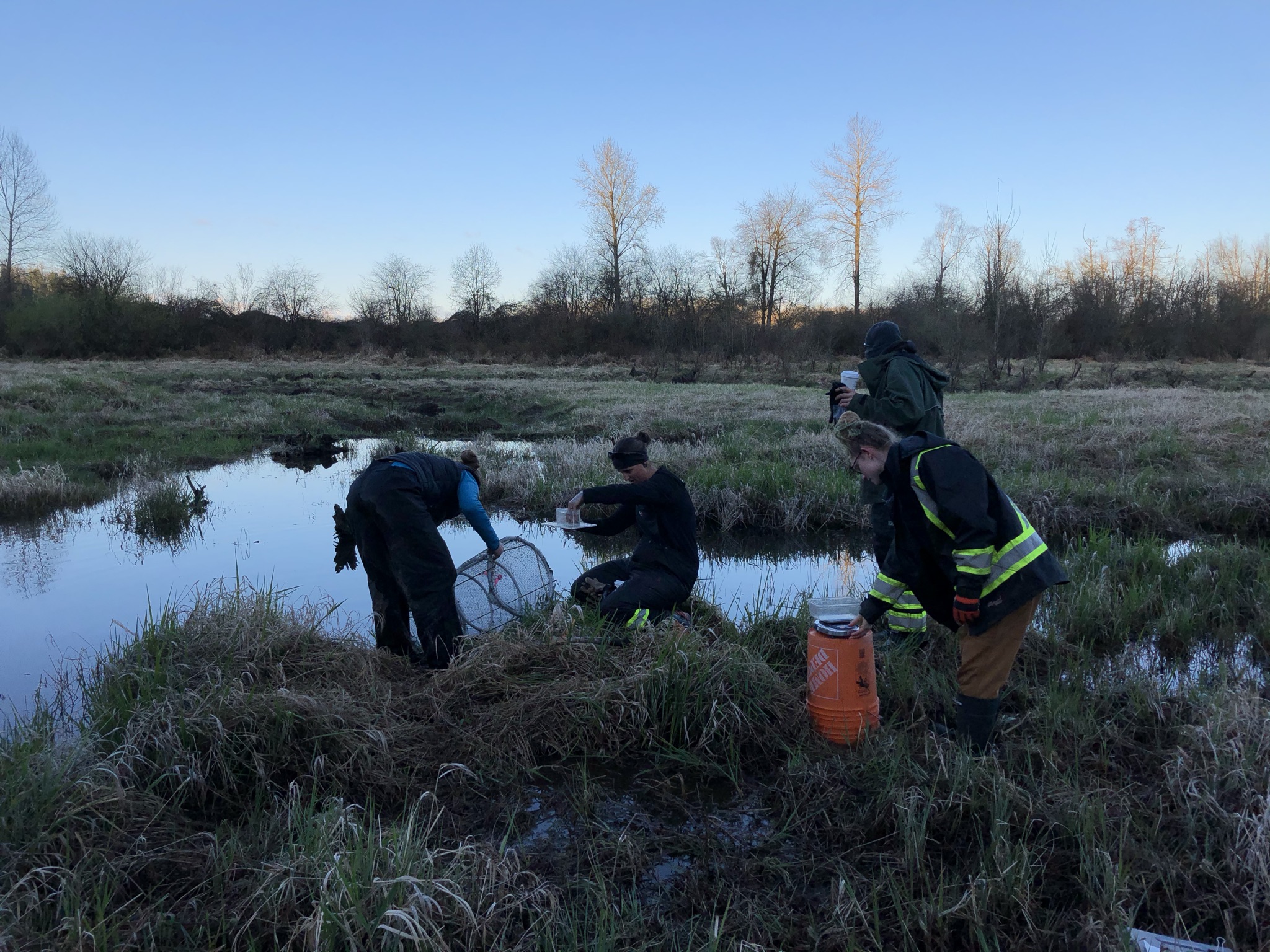
photo: FVWC staff setting fish traps and measuring water quality at Stave Site #3 in April 2021.
Background
Stave Site #3 spans over both Ducks Unlimited and Kwantlen First Nation Property and is located southeast of the Stave River and south of Silvermere Lake and Highway #7 in Mission, BC. Restoration focused on creating off-channel habitat for rearing and overwintering salmon, increasing the availability of salmon spawning habitat in the lower Stave River, and increasing habitat diversity by reducing reed canary grass (Phalaris arundinacea) invasion.
Summary of Activities
2011-2014:
2014-2015
2015-2016:
Monitoring
Monitoring for fish and water quality at Stave Site #3 began in 2015. Fish traps are set and water quality is measured at 10 sampling locations within Site #3 multiple times of the year.


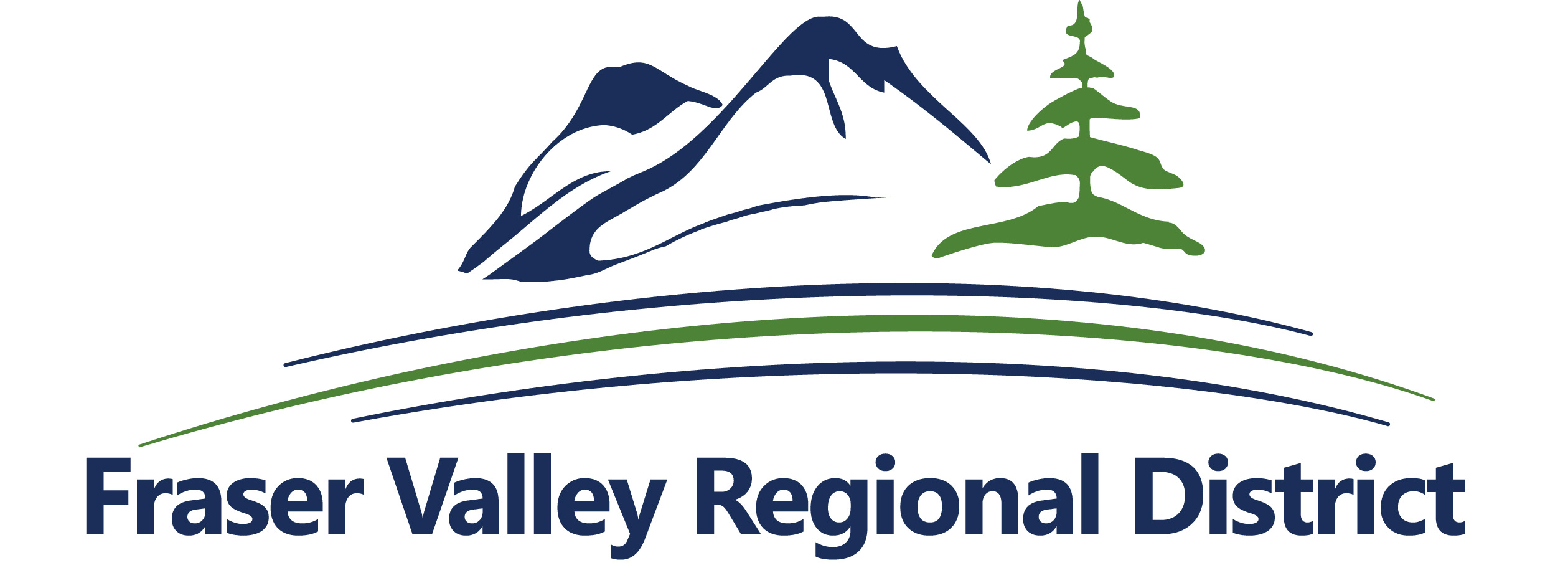

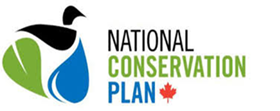
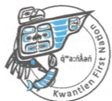


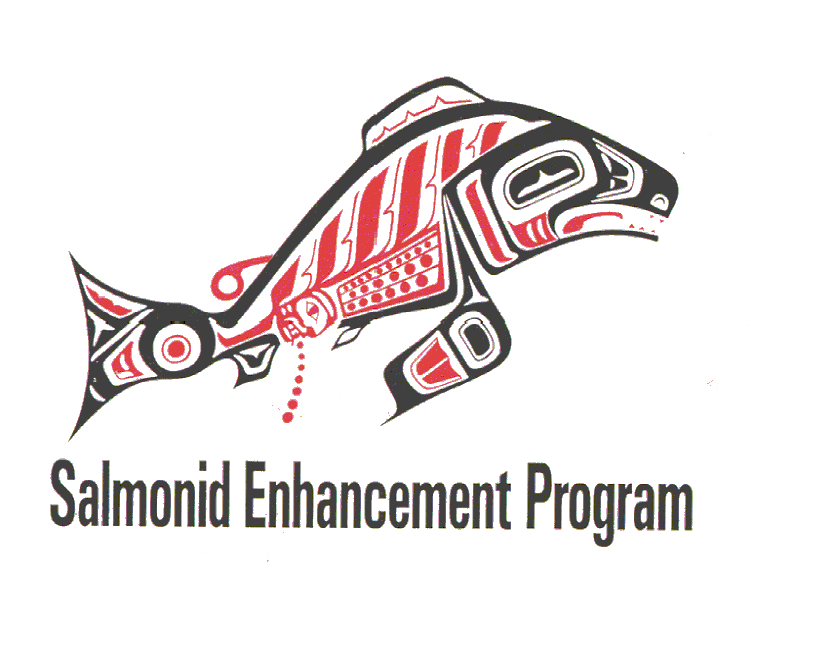




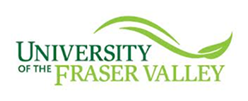



This is a block of text. Double-click this text to edit it.